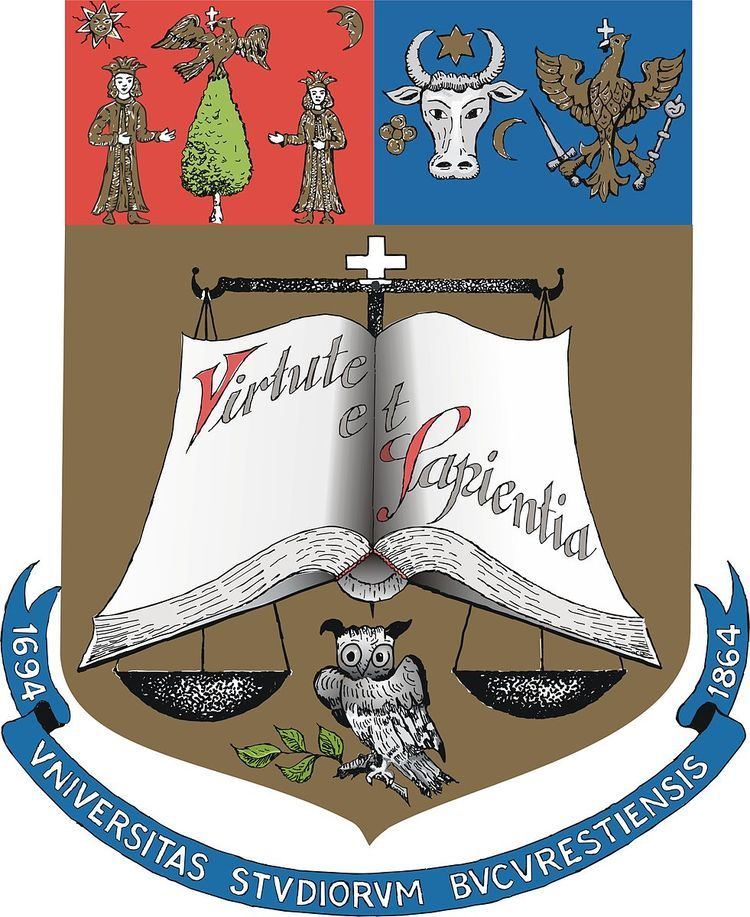Academic staff 1,279 Undergraduates 21,772 Founded 1864 Total enrollment 32,530 (2012) Rector Mircea Dumitru | Established 1864 Students 31,805 (2012-2013) Undergraduate tuition and fees 3,100 RON (2010) Phone +40 21 307 7300 | |
 | ||
Address Bulevardul Regina Elisabeta 4-12, București 030018, Romania Notable alumni Similar Bucharest Academy of Econo, Politehnica University of Buchar, Alexandru Ioan Cuza University, Spiru Haret University, Babeș‑Bolyai University Profiles | ||
Welcoming students at the university of bucharest
The University of Bucharest (Romanian: Universitatea din București), commonly known after its abbreviation UB in Romania, is a public university founded in 1864 by decree of Prince Alexandru Ioan Cuza to convert the former Saint Sava Academy into the current University of Bucharest, making it the second oldest modern university in Romania. The University of Bucharest offers study programmes in Romanian and English and is classified as an advanced research and education university by the Ministry of Education. In the 2012 QS World University Rankings, it was included in the top 700 universities of the world, together with three other Romanian universities.
Contents
- Welcoming students at the university of bucharest
- Willem c vis university of bucharest 2015 2016
- History
- Post 1989 history
- Ranking
- Faculties
- International Programs
- Buildings
- References
Willem c vis university of bucharest 2015 2016
History
In 1694 Constantin Brâncoveanu, ruler of Wallachia, had founded the Princely Academy of Saint Sava in Bucharest with lectures delivered in Greek. In 1776, Alexander Ypsilantis, ruler of Wallachia, reformed the curriculum of the Saint Sava Academy, where courses of French, Italian and Latin were now taught. In 1859, the Faculty of Law was created. In 1857, Carol Davila created the Carol Davila University of Medicine and Pharmacy. In 1857, the foundation stone of the University Palace in Bucharest was laid.
On July 4/16 1864 Prince Alexander John Cuza created the University of Bucharest, bringing together the Faculties of Law, Sciences and Letters as one single body. In the following years, new faculties were created: 1884 – the Faculty of Theology; 1906 – the Institute of Geology; 1913 – the Academic Institute for Electrotechnology; 1921 – the Faculty of Veterinary Medicine; 1923 – the Faculty of Pharmacy, 1924 – the Mina Minovici Institute of Forensic Medicine.
In 1956, student leaders, mainly from this university, planned a peaceful protest against Romania's Communist regime but were forcibly prevented from carrying it out. (See Bucharest student movement of 1956)
For a while (1950s-early 1960s?), it was called the "C. I. Parhon University", after C. I. Parhon.
Post-1989 history
The area around the old University building (the University Square), adjacent to the C. A. Rosetti, Roman, Kogălniceanu, and Union Squares was the scene of many riots, protests and clashes with the security forces during the Romanian Revolution of 1989. During the months of April–June 1990, the University of Bucharest was the centre of anti-communist protests.
In 1996, Emil Constantinescu, the then rector of the University of Bucharest, was elected President of Romania, after defeating Ion Iliescu in national presidential elections.
Ranking
In the 2012 QS World University Rankings University of Bucharest was included in the Top 601 + 701 universities of the world, together with three other Romanian universities, including Babeș-Bolyai University in Cluj-Napoca, and Alexandru Ioan Cuza University in Iași
Faculties
The University of Bucharest has 19 faculties, covering fields such as natural sciences, humanities, social sciences, and theology:
The University also has a publishing house, different research institutes and research groups (such as the Institute for Political Research, the Institute for Mathematics, the Center for Byzantine Studies, the Vasile Pârvan Archeology Seminary, the Center for Nuclear Research, etc.), master and doctorate programmes, and a number of lifelong learning facilities and programmes. It has partnership agreements with over 50 universities in 40 countries, and participates in European programmes such as ERASMUS, Lingua, Naric, Leonardo da Vinci, UNICA, AMOS, TEMPUS, TEMPRA. It is an accredited Cisco Academy, has Microsoft curriculum, and is accredited by Red Hat for its academic programme.
The University of Bucharest has been awarded the 2000 National Academic Excellence Diploma, and the 2004 National Academic Excellence Medal. All of the degrees and diplomas awarded by the university are internationally recognised.
International Programs
The University of Bucharest is a member of international organisations including: - The Association of Universities in European Capitals (UNICA) - The Network of South-East European Universities - The European University Association (EUA) - Agence Universitaire de la Francophonie (AUF) - Black Sea Universities Network (BSUN) - Academic Cooperation Association (ACA) - European Inter-University Centre for Human Rights and Democratization (EIUC) - Eurasian Universities Union (EURAS) - SEE GRID - South-East Europe GRID - 2005 - Central European Exchange Program for University Studies (CEEPUS) - ERASMUS NETWORK EUE-NET - Educational Structutre in Europe, Phase IV (TUNING) - European Physics Education Network (EUPEN) - Stakeholders Tune European Physics Studies (STEPS)
As part of on-going ERASMUS programme, the University of Bucharest has approximately 225 Erasmus agreements with European partner universities.
Buildings
The University of Bucharest has a number of buildings throughout Bucharest, so in that respect it does not have a single campus. Its two main buildings are:
Other faculties have their own buildings and research facilities, scattered throughout the city, such as:
The University prints a yearly guide for freshmen.
